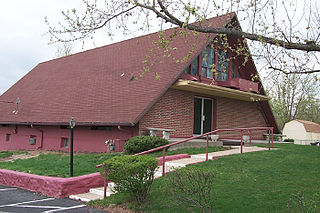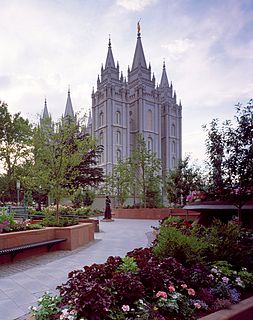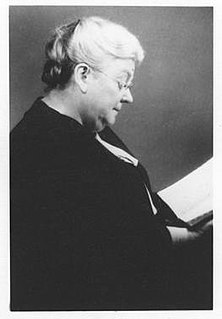
The Church of Christ, informally called Hedrickites and the Church of Christ , is a denomination of the Latter Day Saint movement headquartered in Independence, Missouri, on what is known as the Temple Lot. The nickname for members of the church comes from the surname of Granville Hedrick, who was ordained as the church's leader in July 1863. Unlike The Church of Jesus Christ of Latter-day Saints and Community of Christ, the Temple Lot church rejects the office of prophet or president, being instead led by its Quorum of Twelve Apostles. The church also rejects the doctrines of baptism for the dead and celestial marriage promulgated by the Utah-based LDS Church, as well as the Doctrine and Covenants and Pearl of Great Price. While once avidly engaged in dialogue with other Latter Day Saint factions, the church no longer has any official contact with any other organization. It is notable for its sole ownership of the Temple Lot, which it has held for nearly 150 years. As of 2013, membership is 7,310 members in 11 countries. Most of the members live in the United States, but there are parishes in Canada, Mexico, Honduras, Nigeria, Kenya, Democratic Republic of the Congo, Malawi, Tanzania, India, and the Philippines.

The Church of Christ with the Elijah Message is the name of three related church groups and a denomination of the Latter Day Saint movement, headquartered in Independence, Missouri. It split from the Church of Christ in 1943 in a dispute over claimed revelations given to its founder William A. Draves. Draves, an elder in the Fettingite group, claimed to be receiving messages from an angelic being who identified himself as John the Baptist—the same person who had allegedly appeared to Fettingite founder Otto Fetting, a former apostle of the Temple Lot Church of Christ. While many Fettingites accepted these new missives, some did not, leading Draves to form his own church. His adherents claim it to be the sole legitimate continuation of Fetting's organization, as well as that of the Temple Lot church. As of 1987, the church had approximately 12,500 adherents spread between Africa, Europe, Asia, Australia and the Americas.

The Church of Christ was the original name of the Latter Day Saint church founded by Joseph Smith. Organized informally in 1829 in New York and then formally on April 6, 1830, it was the first organization to implement the principles found in Smith's newly published Book of Mormon, and thus its establishment represents the formal beginning of the Latter Day Saint movement. Later names for this organization included the Church of the Latter Day Saints, the Church of Jesus Christ, the Church of God, the Church of Christ of Latter Day Saints, and the Church of Jesus Christ of Latter Day Saints.

The Latter Day Saint movement is a religious movement within Christianity that arose during the Second Great Awakening in the early 19th century and that led to the set of doctrines, practices, and cultures called Mormonism, and to the existence of numerous Latter Day Saint churches. Its history is characterized by intense controversy and persecution in reaction to some of the movement's doctrines and practices and their relationship to mainstream Christianity. The purpose of this article is to give an overview of the different groups, beliefs, and denominations that began with the influence of Joseph Smith.

Joseph Smith III was the eldest surviving son of Joseph Smith and Emma Hale Smith. Joseph Smith III was the Prophet-President of what became known as the Reorganized Church of Jesus Christ of Latter Day Saints, now called the Community of Christ, which considers itself a continuation of the church established by Smith's father in 1830. For fifty-four years until his own death, Smith presided over the church. Smith's moderate ideas and nature set much of the tone for the church's development, earning him the sobriquet of "the pragmatic prophet".

The Kirtland Temple is a National Historic Landmark in Kirtland, Ohio, United States, on the eastern edge of the Cleveland metropolitan area. Owned and operated by the Community of Christ, formerly the Reorganized Church of Jesus Christ of Latter Day Saints (RLDS), the house of worship was the first temple to be built by adherents of the Latter Day Saint movement. The design mixes the Federal, Greek Revival, and Gothic Revival architectural styles.

In the Latter Day Saint movement, a temple is a building dedicated to be a house of God and is reserved for special forms of worship. A temple differs from a church meetinghouse, which is used for weekly worship services. Temples have been a significant part of the Latter Day Saint movement since early in its inception. Today, temples are operated by several Latter Day Saint denominations. The most prolific builder of temples of the Latter Day Saint movement is The Church of Jesus Christ of Latter-day Saints. There are 170 dedicated temples, 45 under construction, and 50 announced, for a total of 265. Several others within the movement have built, or attempted to build, temples. The Community of Christ operates two temples in the United States, which are open to the public and are used for worship services, performances, and religious education. Other denominations with temples are the Apostolic United Brethren, the Church of Christ, the Fundamentalist Church of Jesus Christ of Latter-Day Saints and the Righteous Branch of the Church of Jesus Christ of Latter-day Saints.

The history of Community of Christ, formerly known as the Reorganized Church of Jesus Christ of Latter Day Saints, covers a period of approximately 200 years. The church's early history traces to the "grove experience" of Joseph Smith, who prayed in the woods near his home in Palmyra, New York, in the early-19th century. Several accounts of this experience have surfaced over the years. Most of the accounts share a common narrative indicating that when he went to the woods to pray, he experienced a period of encountering evil or despair, but then experienced an epiphany or vision in which he came to know and understand God's goodness. Later, as an adult, Smith founded the Church of Christ on April 6, 1830.

Community of Christ and The Church of Jesus Christ of Latter-day Saints are two denominations that share a common heritage in the Church of Christ founded by Joseph Smith on April 6, 1830. Since Smith's death in 1844, they have evolved separately in belief and practices. The LDS Church is headquartered in Salt Lake City, Utah, and claims more than 16 million members worldwide; Community of Christ is headquartered in Independence, Missouri, and reports a worldwide membership of approximately 250,000.
Granville Hedrick was a leader in the Latter Day Saint movement after the 1844 succession crisis. In 1863, Hedrick became the founding leader of the Church of Christ, which is one of many churches that claim to be a continuation of the Church of Christ founded by Joseph Smith in 1830.

The Temple Lot, located in Independence, Missouri, is the first site to be dedicated for the construction of a temple in the Latter Day Saint movement. The area was dedicated on August 3, 1831, by the movement's founder, Joseph Smith Jr., and purchased on December 19, 1831, by his colleague Edward Partridge to be the center of the New Jerusalem or "City of Zion" after he received a revelation stating that it would be the gathering spot of the Latter Day Saints during the last days.

Elbert Aoriul Smith was an American leader in the Reorganized Church of Jesus Christ of Latter Day Saints. He was a member of the church's First Presidency from 1909 to 1938 and the Presiding Patriarch of the church from 1938 to 1958.
The Kirtland Temple Suit is an 1880 Ohio legal case that is often cited as the case that awarded ownership of the Kirtland Temple to the Reorganized Church of Jesus Christ of Latter Day Saints. Though the case was dismissed by the court, the publication of the court's findings of fact—as if they had been the decision of the court—reinforced the belief by members of the RLDS Church and others that the court had considered the RLDS Church, and not The Church of Jesus Christ of Latter-day Saints, the rightful legal successor to the Latter Day Saint church established by Joseph Smith in 1830.

The Church of Christ, informally referred to as the Fettingites, is a denomination within the Latter Day Saint movement which split from the Church of Christ—informally known as "Hedrickites"— in late 1929. The faction was formally established on April 8, 1930, and an Associated Press report published in The New York Times and Los Angeles Times April 7, 1930, describes it as having been briefly named "The Church of Jesus Christ" and later, the "Church of Christ". It is informally referred to as the "Church of Christ (Fettingite)", after its founder, Otto Fetting, but this sect has never officially been named as such. Otto Fetting, an Apostle in the Church of Christ, was the alleged recipient of a series of messages delivered by John the Baptist concerning construction of a temple on the Temple Lot, along with other aspects of Hedrickite doctrine and practice. The rejection of his "Twelfth Message" by a majority vote of his fellow Apostles in October 1929 led to a split in the Temple Lot organization between those who rejected Fetting's messages and those who accepted them. The "Fettingites" subsequently established their own church organization.

The Independence Visitors' Center is a visitors' center owned and operated by The Church of Jesus Christ of Latter-day Saints in Independence, Missouri. The center is situated on the Greater Temple Lot dedicated and purchased by Joseph Smith and his associates in 1831, only a few yards from the Church of Christ 's headquarters and the Community of Christ temple.

The Church of Christ, informally referred to as the Church of Christ (Hancock), the Basement Church, the Church of Christ (Lukeite) and the Church of Christ, was a sect of the Latter Day Saint movement founded in Independence, Missouri in 1946 by Pauline Hancock. This church, which became defunct in 1984, bears the distinction of being the first Latter Day Saint sect to be founded by a woman. Among its members were Jerald and Sandra Tanner, who later became well-known opponents of the Latter Day Saint movement with their "Utah Lighthouse Ministry".

Pauline Bailey Hancock was the founder of the Church of Christ (Hancock) in Independence, Missouri in 1946, and was the first woman to found and lead a denomination in the Latter Day Saint movement. A former member of the Reorganized Church of Jesus Christ of Latter Day Saints and then later the Church of Christ, Hancock was excommunicated from the Temple Lot church in 1935, due to differences between her view of the Godhead and theirs. She later claimed a vision of Jesus Christ, who she claimed had told her to "go and teach," leading her to found her own church in 1946. She would lead this church until her death in 1962.

The following outline is provided as an overview of and topical guide to the Book of Mormon:
















